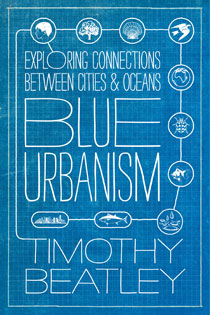"... Beatley expands his purview beyond the 'green urbanism' of Biophilic Cities to the vast oceans that make up 70 percent of the face of the Earth. While he still argues that cities must integrate green—really ecological design principles at all levels—into dense urban environments, he cautions that cities can’t ignore oceans and marine environments."
ASLA's The Dirt
"Timothy Beatley... makes an explicit connection between oceans and cities. He looks at projects that study marine biodiversity near cities and talks about ways to make ports and shipping more ocean friendly using wind and solar power. He encourages urban design to consider ocean health, working toward 'bluer' cities."
Landscape Architecture Magazine
"...a perspective that could certainly expand into city planning."
City Lab
"heartening, a nice dose of optimism in a field (conservation biology) that often focuses on the negative. ... Overall, this is a fun, engaging book. Anyone interested or passionate about urban sustainability or about the health of the oceans should check it out."
The Nature Conservancy's Science Chronicles
"He spends chapters linking urban lifestyles— fish consumption, design, land use — to their oceanic consequences… He collected a myriad of upbeat examples of cities where blue urbanism has shown itself."
Planning
"Beatley gives us a new perspective in viewing water masses (rivers, lakes, seas and oceans) as an extension of our cities and, in the end, an extension of ourselves."
Nature of Cities
"Blue Urbanism is suitable for all who are interested in and concerned about our Blue Planet, and a clarion call for effective engagement with shaping our future. Tim Beatley again offers us a promising vision of different and positive ways to address complex and neglected issues. Connecting the cities where most of us increasingly live with the watersheds and oceansheds that support humans and all that they cherish is vitally important."
Margaret A. Davidson, Acting Director, Office of Ocean and Coastal Resource Management
"Blue Urbanism is an inspiring book for citizens and policymakers alike, full of challenge and ideas. Connecting our cities' populations with the ocean, physically, intellectually and emotionally, is an urgent task for the twenty-first century. Tim Beatley brings examples of biodiversity, engineering, beauty and recreation together from around the world. City leadership must include the marine realm if humans are to be a healthy species on this Blue Planet."
Celia Wade-Brown, Mayor of Wellington, New Zealand
"Tim Beatley provides a cogent argument for intertwining urban and natural worlds, especially for us on the continent's edge. As we add density, Beatley expertly argues that true sustainability must extend to the blue world that defines our globe and shapes our cities."
John Rahaim, Planning Director, San Francisco
"Beatley’s exploration goes well beyond regulatory tools, eventually developing a completely new vision for how we interact with urban marine environments."
Urban Marine Ecology

